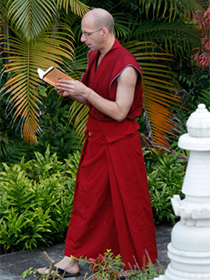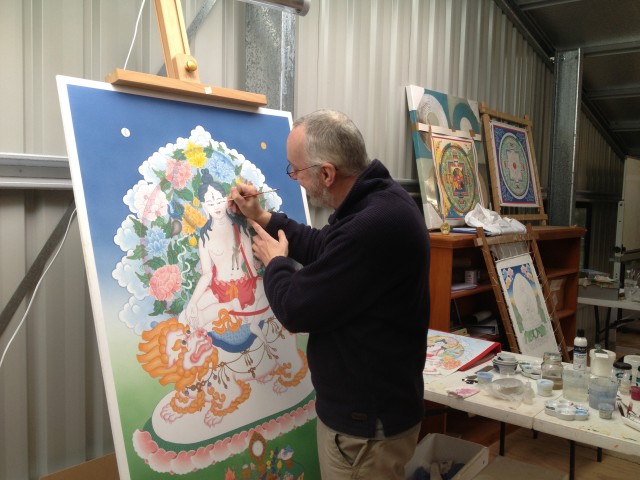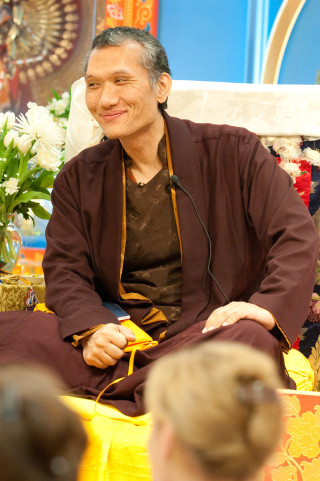- Home
- FPMT Homepage
Foundation for the Preservation of the Mahayana Tradition
The FPMT is an organization devoted to preserving and spreading Mahayana Buddhism worldwide by creating opportunities to listen, reflect, meditate, practice and actualize the unmistaken teachings of the Buddha and based on that experience spreading the Dharma to sentient beings. We provide integrated education through which people’s minds and hearts can be transformed into their highest potential for the benefit of others, inspired by an attitude of universal responsibility and service. We are committed to creating harmonious environments and helping all beings develop their full potential of infinite wisdom and compassion. Our organization is based on the Buddhist tradition of Lama Tsongkhapa of Tibet as taught to us by our founders Lama Thubten Yeshe and Lama Thubten Zopa Rinpoche.
- Willkommen
Die Stiftung zur Erhaltung der Mahayana Tradition (FPMT) ist eine Organisation, die sich weltweit für die Erhaltung und Verbreitung des Mahayana-Buddhismus einsetzt, indem sie Möglichkeiten schafft, den makellosen Lehren des Buddha zuzuhören, über sie zur reflektieren und zu meditieren und auf der Grundlage dieser Erfahrung das Dharma unter den Lebewesen zu verbreiten.
Wir bieten integrierte Schulungswege an, durch denen der Geist und das Herz der Menschen in ihr höchstes Potential verwandelt werden zum Wohl der anderen – inspiriert durch eine Haltung der universellen Verantwortung und dem Wunsch zu dienen. Wir haben uns verpflichtet, harmonische Umgebungen zu schaffen und allen Wesen zu helfen, ihr volles Potenzial unendlicher Weisheit und grenzenlosen Mitgefühls zu verwirklichen.
Unsere Organisation basiert auf der buddhistischen Tradition von Lama Tsongkhapa von Tibet, so wie sie uns von unseren Gründern Lama Thubten Yeshe und Lama Thubten Zopa Rinpoche gelehrt wird.
- Bienvenidos
La Fundación para la preservación de la tradición Mahayana (FPMT) es una organización que se dedica a preservar y difundir el budismo Mahayana en todo el mundo, creando oportunidades para escuchar, reflexionar, meditar, practicar y actualizar las enseñanzas inconfundibles de Buda y en base a esa experiencia difundir el Dharma a los seres.
Proporcionamos una educación integrada a través de la cual las mentes y los corazones de las personas se pueden transformar en su mayor potencial para el beneficio de los demás, inspirados por una actitud de responsabilidad y servicio universales. Estamos comprometidos a crear ambientes armoniosos y ayudar a todos los seres a desarrollar todo su potencial de infinita sabiduría y compasión.
Nuestra organización se basa en la tradición budista de Lama Tsongkhapa del Tíbet como nos lo enseñaron nuestros fundadores Lama Thubten Yeshe y Lama Zopa Rinpoche.
A continuación puede ver una lista de los centros y sus páginas web en su lengua preferida.
- Bienvenue
L’organisation de la FPMT a pour vocation la préservation et la diffusion du bouddhisme du mahayana dans le monde entier. Elle offre l’opportunité d’écouter, de réfléchir, de méditer, de pratiquer et de réaliser les enseignements excellents du Bouddha, pour ensuite transmettre le Dharma à tous les êtres. Nous proposons une formation intégrée grâce à laquelle le cœur et l’esprit de chacun peuvent accomplir leur potentiel le plus élevé pour le bien d’autrui, inspirés par le sens du service et une responsabilité universelle. Nous nous engageons à créer un environnement harmonieux et à aider tous les êtres à épanouir leur potentiel illimité de compassion et de sagesse. Notre organisation s’appuie sur la tradition guéloukpa de Lama Tsongkhapa du Tibet, telle qu’elle a été enseignée par nos fondateurs Lama Thoubtèn Yéshé et Lama Zopa Rinpoché.
Visitez le site de notre Editions Mahayana pour les traductions, conseils et nouvelles du Bureau international en français.
Voici une liste de centres et de leurs sites dans votre langue préférée
- Benvenuto
L’FPMT è un organizzazione il cui scopo è preservare e diffondere il Buddhismo Mahayana nel mondo, creando occasioni di ascolto, riflessione, meditazione e pratica dei perfetti insegnamenti del Buddha, al fine di attualizzare e diffondere il Dharma fra tutti gli esseri senzienti.
Offriamo un’educazione integrata, che può trasformare la mente e i cuori delle persone nel loro massimo potenziale, per il beneficio di tutti gli esseri, ispirati da un’attitudine di responsabilità universale e di servizio.
Il nostro obiettivo è quello di creare contesti armoniosi e aiutare tutti gli esseri a sviluppare in modo completo le proprie potenzialità di infinita saggezza e compassione.
La nostra organizzazione si basa sulla tradizione buddhista di Lama Tsongkhapa del Tibet, così come ci è stata insegnata dai nostri fondatori Lama Thubten Yeshe e Lama Zopa Rinpoche.
Di seguito potete trovare un elenco dei centri e dei loro siti nella lingua da voi prescelta.
- 欢迎 / 歡迎
简体中文
“护持大乘法脉基金会”( 英文简称:FPMT。全名:Foundation for the Preservation of the Mahayana Tradition) 是一个致力于护持和弘扬大乘佛法的国际佛教组织。我们提供听闻,思维,禅修,修行和实证佛陀无误教法的机会,以便让一切众生都能够享受佛法的指引和滋润。
我们全力创造和谐融洽的环境, 为人们提供解行并重的完整佛法教育,以便启发内在的环宇悲心及责任心,并开发内心所蕴藏的巨大潜能 — 无限的智慧与悲心 — 以便利益和服务一切有情。
FPMT的创办人是图腾耶喜喇嘛和喇嘛梭巴仁波切。我们所修习的是由两位上师所教导的,西藏喀巴大师的佛法传承。
繁體中文
護持大乘法脈基金會”( 英文簡稱:FPMT。全名:Found
ation for the Preservation of the Mahayana Tradition ) 是一個致力於護持和弘揚大乘佛法的國際佛教組織。我們提供聽聞, 思維,禪修,修行和實證佛陀無誤教法的機會,以便讓一切眾生都能 夠享受佛法的指引和滋潤。 我們全力創造和諧融洽的環境,
為人們提供解行並重的完整佛法教育,以便啟發內在的環宇悲心及責 任心,並開發內心所蘊藏的巨大潛能 — 無限的智慧與悲心 – – 以便利益和服務一切有情。 FPMT的創辦人是圖騰耶喜喇嘛和喇嘛梭巴仁波切。
我們所修習的是由兩位上師所教導的,西藏喀巴大師的佛法傳承。 察看道场信息:
- FPMT Homepage
- News/Media
-
- Study & Practice
-
-
- About FPMT Education Services
- Latest News
- Programs
- New to Buddhism?
- Buddhist Mind Science: Activating Your Potential
- Heart Advice for Death and Dying
- Discovering Buddhism
- Living in the Path
- Exploring Buddhism
- FPMT Basic Program
- FPMT Masters Program
- FPMT In-Depth Meditation Training
- Maitripa College
- Lotsawa Rinchen Zangpo Translator Program
- Universal Education for Compassion & Wisdom
- Online Learning Center
-
- Prayers & Practice Materials
- Overview of Prayers & Practices
- Full Catalogue of Prayers & Practice Materials
- Explore Popular Topics
- Benefiting Animals
- Chenrezig Resources
- Death & Dying Resources
- Lama Chopa (Guru Puja)
- Lama Zopa Rinpoche: Compendium of Precious Instructions
- Lama Zopa Rinpoche: Life Practice Advice
- Lama Zopa Rinpoche Practice Series
- Lamrim Resources
- Mantras
- Prayer Book Updates
- Purification Practices
- Sutras
- Thought Transformation (Lojong)
- Audio Materials
- Dharma Dates - Tibetan Calendar
- Translation Services
- Publishing Services
- Ways to Offer Support
- Prayers & Practice Materials
-
- Teachings and Advice
- Find Teachings and Advice
- Lama Zopa Rinpoche Advice Page
- Lama Zopa Rinpoche: Compendium of Precious Instructions
- Lama Zopa Rinpoche Video Teachings
- ༧སྐྱབས་རྗེ་བཟོད་པ་རིན་པོ་ཆེ་མཆོག་ནས་སྩལ་བའི་བཀའ་སློབ་བརྙན་འཕྲིན།
- Podcasts
- Lama Yeshe Wisdom Archive
- Buddhism FAQ
- Dharma for Young People
- Resources on Holy Objects
- Teachings and Advice
-
-
*If a menu item has a submenu clicking once will expand the menu clicking twice will open the page.
-
-
- Centers
-
- Teachers
-
- Projects
-
-
-
-
*If a menu item has a submenu clicking once will expand the menu clicking twice will open the page.
-
-
- FPMT
-
-
-
-
-
Buddhist meditation doesn’t necessarily mean sitting cross-legged with your eyes closed. Simply observing how your mind is responding to the sense world can be a really perfect meditation and bring a perfect result.
Lama Thubten Yeshe
-
-
-
- Shop
-
-
-
The Foundation Store is FPMT’s online shop and features a vast selection of Buddhist study and practice materials written or recommended by our lineage gurus. These items include homestudy programs, prayers and practices in PDF or eBook format, materials for children, and other resources to support practitioners.
Items displayed in the shop are made available for Dharma practice and educational purposes, and never for the purpose of profiting from their sale. Please read FPMT Foundation Store Policy Regarding Dharma Items for more information.
-
-
Mandala
29
By Garrey Foulkes
In late October, Garrey Foulkes, arts manager of Chenrezig Institute, shared with Mandala an update about the three projects he manages – the Garden of Enlightenment, the Chenrezig Institute Art Studio and the Enlightenment Project for Purification and Merit – and introduces us to Ray Furminger, artist in residence:
For these three projects – the Garden of Enlightenment, the Chenrezig Institute Art Studio and the Enlightenment Project for Purification and Merit, this has been a rather mixed year with an interesting ratio of struggles and successes.
Happily, the positive side of all of this amounts to a very constructive year. Significant repair work, replacing poor-quality casts on the eight stupas in the Garden of Enlightenment and re-painting the decorations, is almost completed thanks to a group of willing and skillful volunteers offering their help despite very hot weather and many large “marsh flies” who enjoy biting people.
The new art studio received a grant to upgrade the parking and landscaping in front of the new building. Our intention is to make this as attractive as possible and encourage visitors to stop, visit the studio, and hopefully find something suitable in our shop to take home with them.
Our resident artist Ray Furminger has now been with us for several year working on a project to complete eight paintings suggested by Rinpoche some years back to be placed on the walls inside the building which houses our large prayer wheel. Needless to say Ray’s skills have been called on to help with many other projects, not the least being a great deal of intricate art work finishing the decorations in the garden in time for His Holiness’ visit some years back.
Since this visit, we have had consistent visits to the center from a large number of school students studying different world religions. These tours happen on roughly a monthly basis and Ray, along with others, give talks on Tibetan iconography and answer basic questions relating to the project.
Ray has been holding regular art workshops at Chenrezig Institute that continue to have good attendance from the local area and Brisbane city. Several students come on a daily basis to paint under his guidance. The energy, good humor and emerging talent among the people working on a daily basis at the art studio gives us great hope for the future.
Ray is a long-time student of Andy Weber, who also comes to the center every year and holds intensive art courses in traditional thangka painting. Assisted by Ray, Andy’s course last September was attended by around 20 people and was seen by all as a great success. It really is quite inspiring to see the changes that these students undergo once they begin to learn the intricacies and symbolism of traditional art and, in many cases, overcome their lack of confidence in their own latent skills and produce some amazing work.
Our big challenge with Ray is to try and find a way keep him here. Ray is British and is currently here on a soon-to-expire extended visa. Australian regulations regarding overseas visitors are now very tight so we need to apply for a special visa that recognizes his great skills as a teacher of traditional spiritual art.
The Enlightenment Project for Purification and Merit, since moving back to Chenrezig Institute, now has its own special space in the new art studio. We are encouraging all of the regional centers to look at what we produce and consider placing stock in their own center shops. Stupas that are required for the Garden of Enlightenment and for other places will also be produced in this workshop. We currently have quite a big commission for Singapore and an ongoing need for more stupas in the gardens.
Updated websites are being worked on so that more people in the region and around the world can see what we have to offer. Several students have ordered molds for tsa-tsa’s relating to their particular practices and commitments. We have a large range to select from.
We are fortunate to have a couple of very skilled three-dimensional artists involved with the project and our intention is to also produce molds for a variety of non-Dharma products like fountains, bird-baths, etc. to display at our sales outlet. Hopefully this will enable us to bring in some extra income that is outside of holy objects and this money can be used in a more general way to keep us functioning by allowing our workers to take a small income.
Chenrezig Institute on Australia’s Sunshine Coast is an active and vibrant Dharma center, offering a robust selection of retreats, workshops and events. Check out their Facebook page for photos and announcements.
- Tagged: chenrezig institute, garrey foulkes, mandala, ray furminger
- 0
29
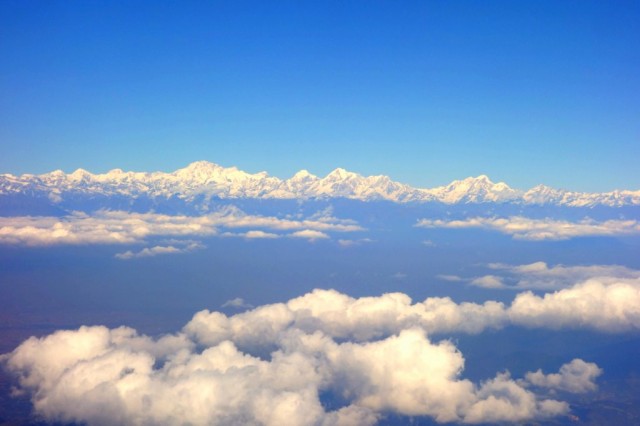
View of the Himalayas from an airplane window, taken during Lama Zopa Rinpoche’s recent journey to Kathmandu, Nepal, November 22, 2013. Photo by Ven. Roger Kunsang.
FPMT Spiritual Director Lama Zopa Rinpoche recently returned to Kopan Monastery in Nepal, the country of his birth. Rinpoche comes from the Solu Khumbu region of Nepal. He was born not far from where his previous incarnation, Lama Kunsang Yeshe, known as the Lawudo Lama, meditated.
Today the Lawudo Lama’s cave is part of Lawudo Gompa and Retreat Centre, an FPMT retreat facility known to be a very special place by all who visit. FPMT has several centers and projects in Nepal in addition to Lawudo Gompa and Kopan Monastery. You can see photos online from these many activities, featured in Mandala January-March 2013. You can read more about Lawudo on FPMT International Office’s and Mandala’s websites.
Learn more about Lama Zopa Rinpoche, spiritual director of the Foundation for the Preservation of Mahayana Tradition (FPMT), and Rinpoche’s vision for a better world. Sign up to receive news and updates.
- Tagged: lama zopa rinpoche, lawudo, mandala, nepal
- 0
28
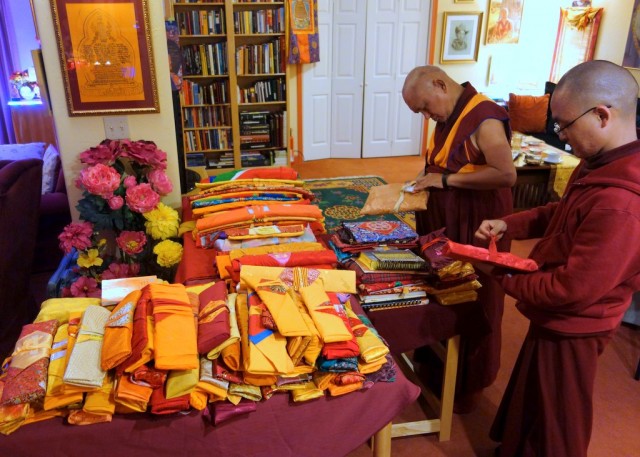
Lama Zopa Rinpoche checking texts the night before departing for Nepal, Kachoe Dechen Ling, California, November 19, 2013. Photo by Ven. Roger Kunsang.
“The night before departure to Nepal, Lama Zopa Rinpoche is searching through his texts to make sure all is there,” said Ven. Roger Kunsang, Rinpoche’s assistant, describing the scene at Kachoe Dechen Ling. “These texts we have to pack, and there are more! Most of the luggage is texts – six suitcases – then ritual items for initiations and then miscellaneous items. We will be packing well into the early morning … when we leave.”
Lama Zopa Rinpoche is the spiritual director of the Foundation for the Preservation of Mahayana Tradition (FPMT), an organization dedicated to preserving Mahayana Buddhism through offering the Buddha’s authentic teachings and to facilitating reflection, meditation, practice and the opportunity to actualize and directly experience the Buddha’s teachings. Sign up to receive news and updates.
- Tagged: lama zopa rinpoche, mandala
- 0
26

Geshe Tarchin, resident geshe at Chandrakirti Meditation Centre, on the cover of the Nelson Mail blessing a chicken. Photo courtesy of Enlightenment for the Dear Animals.
From Phil Hunt and Tania Duratovic, project coordinators and founders of Enlightenment for the Dear Animals and coordinators of the Animal Liberation Sanctuary in Nepal:
World Animal Day was celebrated across the globe on October 4, 2013. At Chandrakirti Meditation Centre in New Zealand, Geshe Tharchin and students visited the Nelson SPCA and blessed all the animals (which made the front page of the local paper!), as well as blessing the beings in the ocean. The students pledged to be vegetarian for the day and the center screened 108 Yaks in the evening.
In Bangalore, India, Choe Khor Sum Ling also screened 108 Yaks, visited a local animal shelter and made donations for the animals.
A student in Germany committed to go vegetarian for October with the hope to make it last longer.
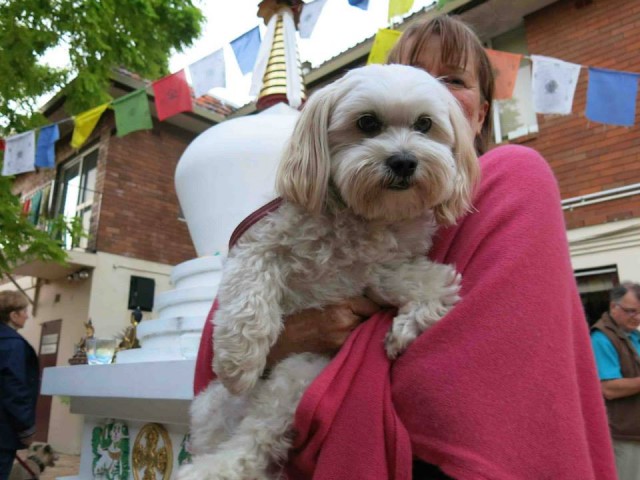
Animals were blessed on World Animal Day at Vajrayana Institute’s stupa, Ashfield, Australia, October 2013. Photo courtesy of Enlightenment for the Dear Animals.
At Vajrayana Institute, Australia, students brought their pets and resident teacher Geshe Samten lead the animal blessing and many circumambulations of the stupa.
Enlightenment for the Dear Animals wants to know how you celebrated World Animal Day, email info@enlightenmentforanimals.org or visit their Facebook page to share.
Mandala brings you news of Lama Zopa Rinpoche and of activities, teachings and events from over 160 FPMT centers, projects and services around the globe. If you like what you read on Mandala, consider becoming a Friend of FPMT, which supports our work.
- Tagged: animals, enlightenment for the dear animals, mandala
- 0
25
‘The Guards Say We’re Crazy’
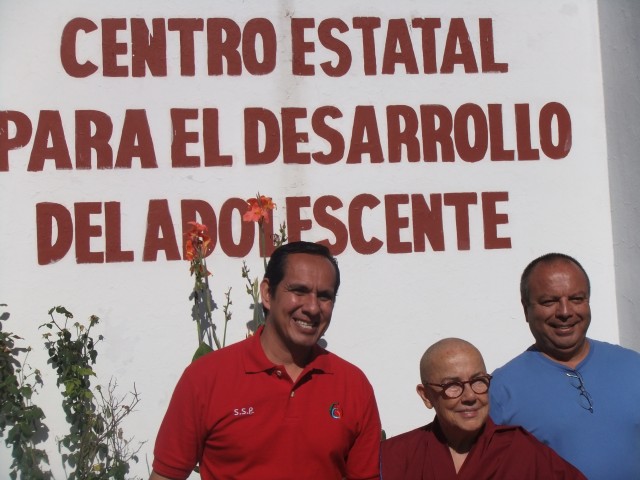
Rogelio Pallares Valdes (blue shirt) with Ven. Robina Courtin and prison staff at the Centro Estatal para el Desarrollo del Adolescente, October 2012. Photo courtesy of Rogelio Pallares Valdes.
Spiritual program coordinator Rogelio Pallares Valdes from Bengungyal Center in Aguascalientes, Mexico, shares a personal account from his Liberation Prison Project work through the center:
The men’s prison located in Aguascalientes, Mexico, requested Bengungyal Center to begin offering courses in the prison’s units 7 and 8, beginning in the second half of 2013. We were told that these units are highly dangerous, with criminals sentenced to 40 or more years in prison.
On September 6, I went there to start the course “Working with Afflictive Emotions.” I arrived to the appointment on time and started the paperwork as I usually do. The difference this time was that the prisoners would not attend a classroom or auditorium. Instead, I had to enter the unit where these special prisoners are kept. It’s something like a prison within the prison.
The guards let me into units 7 and 8, and I walked down the corridors. I saw some prisoners walking from one side to another, not lifting their heads, their eyes darting. Others were standing motionless and seeing nothing. Then, a prisoner came to a gate and through it he asked me, “Are you looking for the guard?”
When I heard his voice, it was obvious that he was under the influence of a tranquilizer. I answered yes.
“Where you come from?”
“Bengungyal Center to talk about emotions.”
“Good! No one visits us. The guards say we’re crazy. If I was crazy, I could not talk to you. Right?”
“Of course not!”
When the guard arrived, he opened the gate and invited me to go inside. I went to the unit dining room and there met six people – my students.
It was hard to tell if I was in a mental hospital or in a prison. During the teaching, they continuously interrupted me, making comments about God’s word or other references they had heard about in the Bible. Most of them were on tranquilizers and struggled to overcome the effects of drugs and understand me. One of them even left to put some water on his head.
One of them asked me if I could do something so that he would no longer be required to take pills, because his hands were shaking and he felt worse each day. My response was automatically institutional: “I must be respectful of the instructions of the authorities. I cannot intervene. I’m sorry.” As I said these words, I felt a great powerlessness. And I felt immensely sad seeing the expression on his face as he heard my words.
When I left, I broke a small prison rule and went to each of them and hugged them as I said goodbye.
Liberation Prison Project is an FPMT international project dedicated to supporting students in prison who wish to study Dharma.
Mandala brings you news of Lama Zopa Rinpoche and of activities, teachings and events from over 160 FPMT centers, projects and services around the globe. If you like what you read on Mandala, consider becoming a Friend of FPMT, which supports our work.
- Tagged: bengungyal center, liberation prison project, mandala, mexico
- 0
25
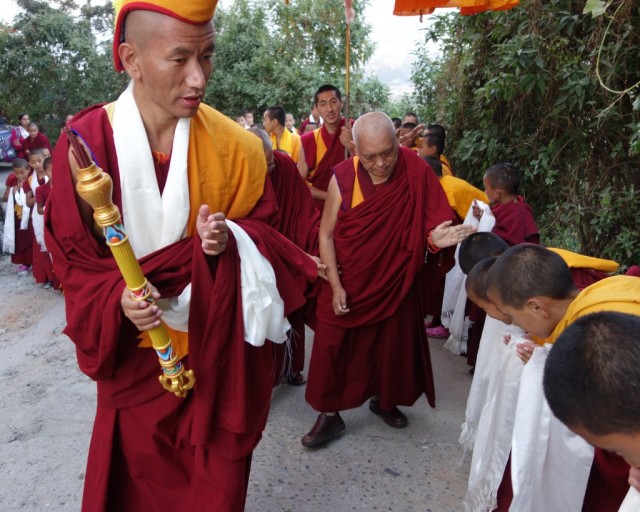
Lama Zopa Rinpoche being led by the Kopan disciplinarian as Rinpoche is greeted by Kopan monks, Nepal, November 22, 2013. Photo by Ven. Roger Kunsang.
Rinpoche arrived at Kopan Monastery in Nepal on November 22. Rinpoche visited the Kopan nunnery, Kachoe Ghakyil Ling, first. The nuns greeted Rinpoche, who went into the gompa at the nunnery to make prostrations. Then he went up Kopan hill, where he was greeted by a long line of monks and more than 200 Westerners, who are currently attending the Kopan November course.
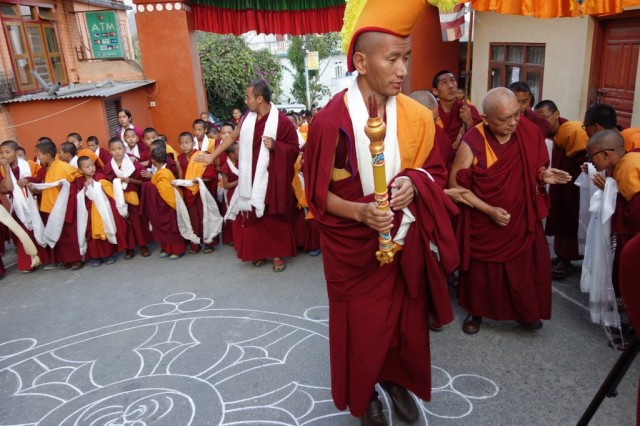
The young monks are among the first to greet Rinpoche upon his return to Kopan Monastery, Nepal, November 22, 2013. Photo by Ven. Roger Kunsang.
“Without wasting a minute, [Rinpoche] walked straight into the gompa and started to give a talk to the November course people,” said Ven. Roger, Rinpoche’s assistant and CEO of FPMT.
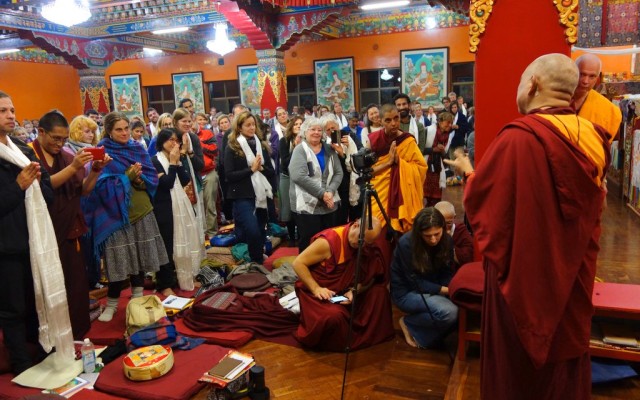
Rinpoche talks to participants of the November course at Kopan Monastery, November 22, 2013. Photo by Ven. Roger Kunsang.
Lama Zopa Rinpoche is the spiritual director of the Foundation for the Preservation of Mahayana Tradition (FPMT), an organization dedicated to preserving Mahayana Buddhism through offering the Buddha’s authentic teachings and to facilitating reflection, meditation, practice and the opportunity to actualize and directly experience the Buddha’s teachings. Sign up to receive news and updates.
- Tagged: kopan course, kopan monastery, lama zopa rinpoche
- 0
Founder and president of Maitripa College Yangsi Rinpoche talks about the development of mindfulness in the August-September 2007 issue of Mandala:
In order to have a faultless practice of calm abiding, we need to develop very strong concentration supported by very strong mindfulness and wisdom. Wisdom in this case refers to the function of mind called introspection, which acts as a kind of security guard for the mind – watching for faults or weaknesses that may arise in our concentration. We should train in the mindfulness possessing three qualities. Our mindfulness must be able to remember the aspect of our object of concentration. It must have the ability to hold that aspect, and it must not be distracted by other objects.
You should seek to develop a concentration that is stable and lasting. In order to be able to bring this about, mindfulness is very important. Of course, even in terms of our ordinary perception, every primary mind is accompanied by five determining factors, one of which is mindfulness. …
From Mandala August-September 2007
20
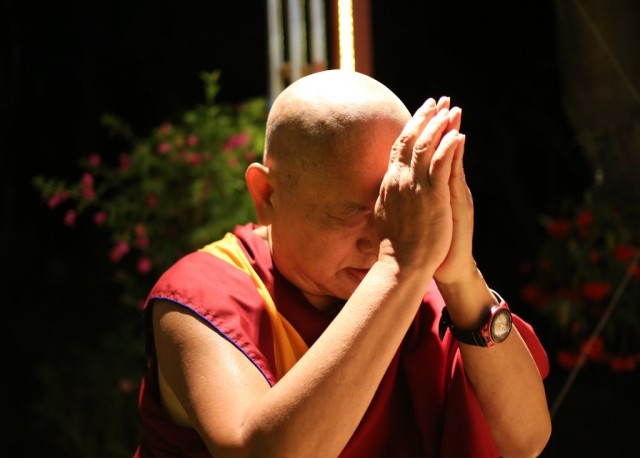
Lama Zopa Rinpoche doing animal liberation practice at Kachoe Dechen Ling, California, November 17, 2013. Photo by Ven. Roger Kunsang.
Lama Zopa Rinpoche regularly does animal liberation practice. At Kachoe Dechen Ling, Rinpoche’s home in California, animal liberation practice is done on a weekly basis even when Rinpoche is not there.
Rinpoche has given the following advice on how to benefit animals:
I started this particular tradition of liberating animals. The way we practice animal liberation causes the person who liberates them to have a long life, but that alone doesn’t ultimately help the animals, so the best thing to do is to circumambulate the animals around holy objects and bless them with mantras and prayers. You can carry animals around a table in the middle of a room with many holy objects on it, like tsa-tsas, pictures of buddhas, and texts.
If there are 1,000 statues and holy objects on a table, then if you take the animals and insects around the table once, it creates 1,000 causes to achieve enlightenment, liberation from samsara, a good rebirth, and happiness in future lives. Each time you carry or lead the animals around the table it creates that many causes for their happiness and long lives. So, if you carry a billion insects around holy objects, you are offering enlightenment each time you circumambulate to that many sentient beings. This is really fantastic, the most amazing benefit that you can offer to other beings. …
You can read the complete advice and more on practices for benefiting animals on the Lama Yeshe Wisdom Archive’s “Lama Zopa Rinpoche Online Advice Book.”
More information, photos and updates about FPMT spiritual director Lama Zopa Rinpoche can be found on Rinpoche’s homepage. If you’d like to receive news of Lama Zopa Rinpoche via email, sign up to Lama Zopa Rinpoche News.
19
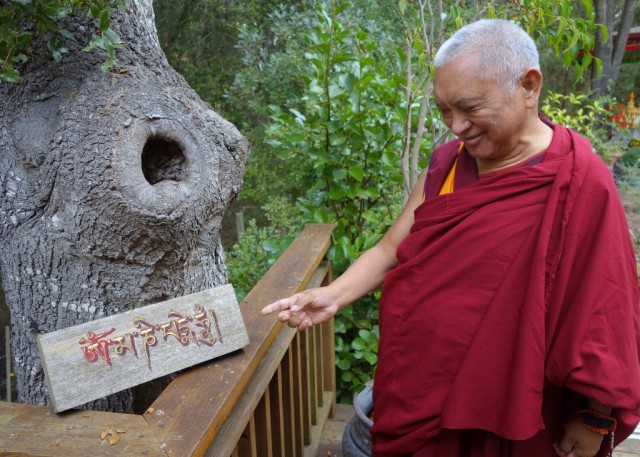
Lama Zopa Rinpoche and OM MANI PADME HUM mantra at Kachoe Dechen Ling, Aptos, California, November 16, 2013. Photo by Ven. Roger Kunsang.
Lama Zopa Rinpoche, while in the garden at Kachoe Dechen Ling, said, “Everywhere you look, you are reminded of Dharma … not samsara.”
Learn more about FPMT spiritual director Lama Zopa Rinpoche and his beneficial activities by visiting Rinpoche’s homepage, where you will find links to Rinpoche’s schedule, new advice, recent video, photos and more.
- Tagged: lama zopa rinpoche, mandala
- 0
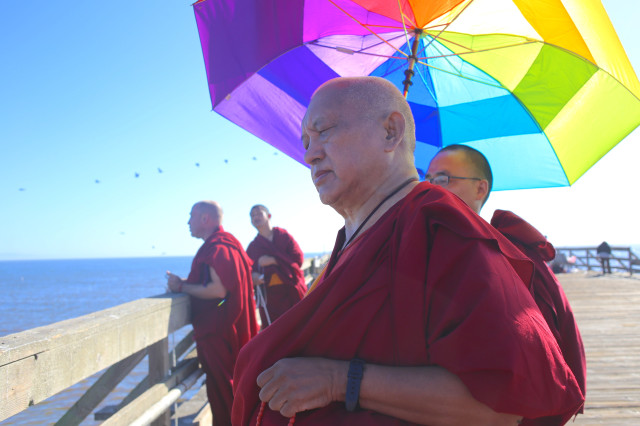
Lama Zopa Rinpoche on wharf near Kachoe Dechen Ling, California, September 2013. Photo by Ven. Thubten Kunsang.
Watch Lama Zopa Rinpoche as he blesses all the sentient beings in the ocean. While Rinpoche has been staying in California, he frequently goes with Sangha and Namgyälma mantra boards to a wharf near Kachoe Dechen Ling or to the beach. The mantra boards are placed in the water and Rinpoche chants mantras, says prayers and pours blessed water into the ocean.
You can watch more videos of Rinpoche blessing all sentient beings in the ocean on the “Lama Zopa Rinpoche Video” page.
More information, photos and updates about FPMT spiritual director Lama Zopa Rinpoche can be found on Rinpoche’s homepage. If you’d like to receive news of Lama Zopa Rinpoche via email, sign up to Lama Zopa Rinpoche News.
- Tagged: animals, mandala, namgyalma mantra
- 0
14
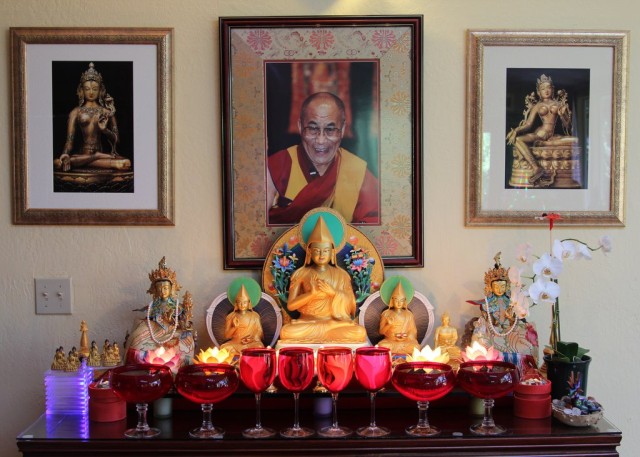
One of the altars at Kachoe Dechen Ling, Aptos, California, November 2013. Photo by Ven. Roger Kunsang.
“… All the suffering of samsara comes from the mind. Happiness, liberation and enlightenment come from the mind. Suffering comes from the unsubdued mind. Liberation and enlightenment come from the subdued mind, therefore, subduing the mind is essential. So what Buddha said is just an example, manifesting numberless forms naturally without effort – as impure forms to sentient beings who have an impure mind, and as pure forms to sentient beings with a pure mind,” Lama Zopa Rinpoche wrote to a new student in a letter recently posted to Lama Yeshe Wisdom Archive’s “Lama Zopa Rinpoche Online Advice Book.”
The letter continues:
“In Buddhism, especially in Mahayana Buddhism, guru devotion is the root of the path to enlightenment. The Buddha’s 84,000 teachings have three levels. There are the Hinayana (Lesser Vehicle) teachings for the lower capable being. For those with greater intelligence and capacity, Buddha revealed the Mahayana Paramitayana teachings. Then for those with higher intelligence, merit or capacity, Buddha taught Mahayana Secret Mantra – Vajrayana.
“In Hinayana, we don’t look at the guru as a buddha, but we respect the guru as if he is a buddha and we obey the guru, the abbot who grants ordination and gives teachings. In Mahayana Paramitayana, we look at the guru as a buddha, having no mistakes but only qualities. In tantra, on that basis – seeing the guru as a buddha – we look at the guru in the pure form of a buddha, we look at the essence as a buddha.
“Obedience is most important, otherwise we cannot achieve realizations; we cannot achieve enlightenment. …”
You can read the entire letter on the Lama Yeshe Wisdom Archive website.
Lama Zopa Rinpoche is the spiritual director of the Foundation for the Preservation of Mahayana Tradition (FPMT), an organization dedicated to preserving Mahayana Buddhism through offering the Buddha’s authentic teachings and to facilitating reflection, meditation, practice and the opportunity to actualize and directly experience the Buddha’s teachings. Sign up to receive news and updates.
- Tagged: guru devotion, lama zopa rinpoche, mandala
- 0
13
A Buddhist’s Loss of a Beloved Pet
By Tania Duratovic
‘How Long Will It All Take?’
Today I found out that one of our loving cats, Pema, has got cancer. It is in her nose and her throat and there is not much anyone can do. On the phone, the veterinarian even offered to my husband that since she is currently under anaesthetic, they could leave her there, i.e., let her die there and then.
I am looking at a photo of her I have on my laptop as I write this. I am in Kopan Monastery, Kathmandu, Nepal, thousands of miles away from Pema at home in Sydney, Australia, with my husband. Tears are streaming down my face, but not necessarily because she is going to die very soon, but because before she does, she will have to undergo great physical suffering of which I cannot explain to her nor can I do a lot to ease.
The veterinarian, when offering the choice to “euthanize” Pema, did so in the belief that this was a good option to avoid her suffering. However, as Buddhists, doing such a thing is prematurely ending another’s life, i.e., killing, even though one believes one is doing so out of compassion. The suffering that being is experiencing will still need to be experienced somewhere, sometime and may even end up being greater.
But when we as Buddhists choose to “put down” an animal, what really is our motivation? Ending our suffering or our pets’? I know I am totally dreading when Pema’s cancer starts to take more of an effect and she begins to feel the pain and miserableness of it all. I feel for my husband who is all alone at home trying to deal with this. I am torn between rushing home and leaving my work here at the Animal Liberation Sanctuary or staying to take care of the animals’ needs here, which are many. Much of me wants to see Pema, to stroke her, to say soothing words to her, but another part of me doesn’t want to see her deteriorate or have to say goodbye.
Pema for the moment is reasonably OK. She is still talkative, though perhaps a little less, and is still, thank goodness, eating, although has lost a substantial amount of weight. “How long will it all take?” I ask over the phone. I know the answer. There is none – no one knows. Why? Because most people do not wait to find out how long it takes for their pet to die. They choose the option to euthanize.
- Tagged: animals, mandala, tania duratovic
- 0
- Home
- News/Media
- Study & Practice
- About FPMT Education Services
- Latest News
- Programs
- New to Buddhism?
- Buddhist Mind Science: Activating Your Potential
- Heart Advice for Death and Dying
- Discovering Buddhism
- Living in the Path
- Exploring Buddhism
- FPMT Basic Program
- FPMT Masters Program
- FPMT In-Depth Meditation Training
- Maitripa College
- Lotsawa Rinchen Zangpo Translator Program
- Universal Education for Compassion & Wisdom
- Online Learning Center
- Prayers & Practice Materials
- Overview of Prayers & Practices
- Full Catalogue of Prayers & Practice Materials
- Explore Popular Topics
- Benefiting Animals
- Chenrezig Resources
- Death & Dying Resources
- Lama Chopa (Guru Puja)
- Lama Zopa Rinpoche: Compendium of Precious Instructions
- Lama Zopa Rinpoche: Life Practice Advice
- Lama Zopa Rinpoche Practice Series
- Lamrim Resources
- Mantras
- Prayer Book Updates
- Purification Practices
- Sutras
- Thought Transformation (Lojong)
- Audio Materials
- Dharma Dates – Tibetan Calendar
- Translation Services
- Publishing Services
- Teachings and Advice
- Find Teachings and Advice
- Lama Zopa Rinpoche Advice Page
- Lama Zopa Rinpoche: Compendium of Precious Instructions
- Lama Zopa Rinpoche Video Teachings
- ༧སྐྱབས་རྗེ་བཟོད་པ་རིན་པོ་ཆེ་མཆོག་ནས་སྩལ་བའི་བཀའ་སློབ་བརྙན་འཕྲིན།
- Podcasts
- Lama Yeshe Wisdom Archive
- Buddhism FAQ
- Dharma for Young People
- Resources on Holy Objects
- Ways to Offer Support
- Centers
- Affiliates Area
- Teachers
- Projects
- Charitable Projects
- Make a Donation
- Applying for Grants
- News about Projects
- Other Projects within FPMT
- Support International Office
- Projects Photo Galleries
- Give Where Most Needed
- FPMT
- Shop
Subscribe to FPMT News
Translate*
*powered by Google TranslateTranslation of pages on fpmt.org is performed by Google Translate, a third party service which FPMT has no control over. The service provides automated computer translations that are only an approximation of the websites' original content. The translations should not be considered exact and only used as a rough guide.The essence of the guru is wisdom: the perfectly clear and radiant state of mind in which bliss and the realization of emptiness are inseparably unified.







